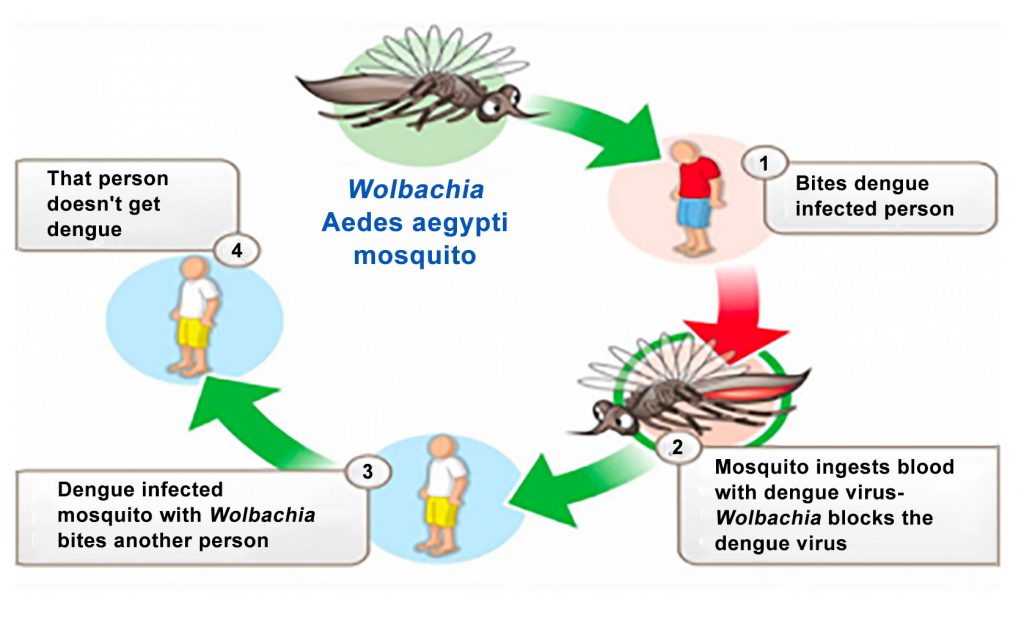The Wolbachia Method is a biological method to manipulate mosquito populations and hence reduce transmission of mosquito-borne diseases such as Dengue, Zika, Chikungunya, etc.
How Does the Wolbachia Method Work?
Wolbachia is a bacteria naturally present in many insects. The Wolbachia method involves introducing this bacteria in mosquito populations through one of the following methods:
- Egg Injection: Wolbachia bacteria is injected into the eggs of Aedes aegypti mosquitoes. Thereafter, they are released into the wild.
- Larval Exposure: Wolbachia bacteria is introduced into Larvae by exposing it to Wolbachia-infused water.
- Male Releases: This method involves releasing Wolbachia-infected male mosquitoes into the wild. These male mosquitos then mate with wild female mosquitos, passing on the bacteria to their offspring.
Wolbachia, once introduced into mosquitoes, has two types of effects:
- Interfering with the reproduction process of mosquitos through a phenomenon called cytoplasmic incompatibility. This incompatibility reduces the number of viable offspring of the mosquitos. Thus, the result is a potential decline in the mosquito population.
- Inhibiting the replication of certain pathogens within the mosquito. This reduces the ability of mosquitoes to transmit diseases.
As Wolbachia infects the eggs or sperm of its host organism, it is transmitted from one generation of mosquitos to the next. Thus, the bacterium spreads rapidly within the mosquito population, making it a powerful tool in mosquito-borne disease control.

Significance of the Wolbachia Method
- It has the potential to emerge as a groundbreaking strategy for vector-borne disease control.
- By providing an effective tool to fight against fatal diseases such as Dengue, Zika, Chikungunya, etc, it can significantly reduce the global burden of illness and mortality.
- It could provide a revolutionary approach to control the population of mosquitoes and other unwanted insects.
- By providing valuable insights into the intricate relationships between microorganisms and their hosts, it underscores the importance of addressing global health challenges through an interdisciplinary approach.
Pros of the Wolbachia Method
| Sustainable | As Wolbachia bacteria are transmitted from one generation of mosquitos to the next, the Wolbachia-infected population can persist for years. Thus, one introduced, this intervention requires minimal intervention to keep it ongoing. |
| Cost-effective | Compared to traditional methods of mosquito control like insecticide spraying, the Wolbachia Method is relatively cost-effective. |
| Targeted | The method specifically targets the Aedes aegypti mosquito, and has almost nil impacts on other insect species. |
| Environmentally Friendly | By reducing the use of chemicals like insecticides, it protects the environment as well as public health. |
Cons of the Wolbachia Method
- It is not effective in controlling all vector-borne diseases.
- Implementing and scaling up Wolbachia-based interventions have its own challenges.
- It raises a concern regarding the manipulation of reproductive processes in other organisms.
Despite these cons, the Wolbachia Method can offer a sustainable and targeted approach to combating vector-borne diseases. Its successful implementation can help improve public health and well-being across the world.
Related Concepts
Vector- Borne Disease
A vector-borne disease refers to an infectious illness caused by the transmission of pathogens (disease-causing microorganisms such as bacteria, viruses, fungi, or parasites) from one host organism to another through vectors. Some prominent examples of vector-borne diseases are – Chikungunya, Dengue, Malaria, Lymphatic filariasis (Filaria), Kalaazar, Rift Valley fever, Yellow Fever, Zika, etc.
Pathogens
Pathogens refer to disease-causing microorganisms such as bacteria, viruses, fungi, or parasites.
Vectors
Vectors are living organisms that can carry pathogens from one host organism to another. Some common examples of vectors include mosquitoes, ticks, fleas, sandflies, etc.
National Vector Borne Disease Control Programme (NVBDCP)
It is an umbrella program launched by the Government of India for the prevention and control of major vector-borne diseases in India viz., Malaria, Lymphatic filariasis, Kalaazar, Japanese encephalitis (JE), Dengue/Dengue Hemorrhagic Fever (DF/DHF) and Chikungunya.
Related UPSC Prelims PYQs
UPSC Prelims 2023 Question
a) Controlling the viral diseases spread by mosquitoes
b) Converting crop residues into packing material
c) Producing biodegradable plastics
d) Producing biochar from thermochemical conversion of biomass
Correct Answer: Option (a)

